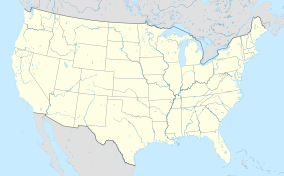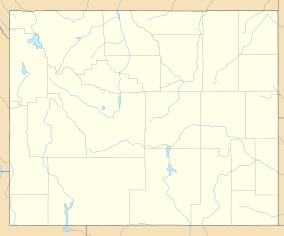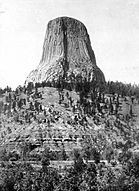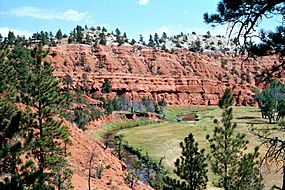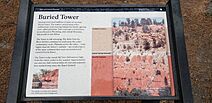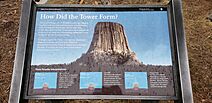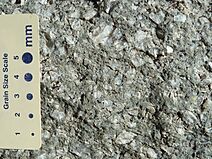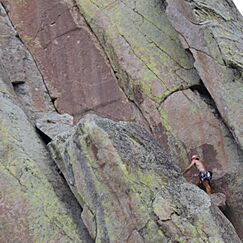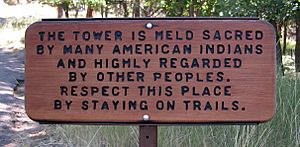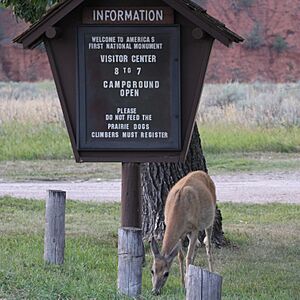Devils Tower facts for kids
Quick facts for kids Devils Tower(Bear Lodge) |
|
|---|---|
| Matȟó Thípila (Lakota), Daxpitcheeaasáao (Crow) | |
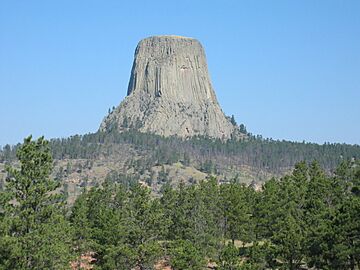 |
|
| Highest point | |
| Elevation | 5,112 ft (1,558 m) NAVD 88 |
| Geography | |
| Location | Crook County, Wyoming, United States |
| Parent range | Bear Lodge Mountains, part of the Black Hills |
| Topo map | USGS Devils Tower |
| Geology | |
| Mountain type | Laccolith |
| Climbing | |
| First ascent | William Rogers and Willard Ripley, July 4, 1893 |
| Easiest route | Durrance Route |
| Devils Tower National Monument | |
|---|---|
|
IUCN Category III (Natural Monument)
|
|
| Nearest city | Hulett, Wyoming |
| Area | 1,346 acres (5.45 km2) |
| Established | September 24, 1906 |
| Visitors | 499,031 (in 2017) |
| Governing body | National Park Service |
| Website | Devils Tower National Monument |
Devils Tower is a huge, unique rock formation in northeastern Wyoming, USA. It's also known as Mato Tipila or Bear Lodge by Native American tribes. This amazing tower is made of igneous rock, which is rock formed from cooled magma. It stands tall above the Belle Fourche River, rising about 1,267 feet (386 meters) from the riverbed. From its base to its top, it's about 867 feet (264 meters) high. The very top of Devils Tower is 5,112 feet (1,558 meters) above sea level.
On September 24, 1906, President Theodore Roosevelt declared Devils Tower the very first National Monument in the United States. This means it's a special place protected by the government. The monument covers an area of about 1,347 acres (545 hectares).
Contents
What's in a Name?
Many Native American tribes have their own names for this impressive rock. Some call it "Bear's House" or "Bear's Lodge." The Lakota call it Matȟó Thípila, and the Crow call it Daxpitcheeaasáao, both meaning "Home of Bears." Other names include "Aloft on a Rock" and "Tree Rock."
The name "Devils Tower" came from an expedition in 1875. An interpreter for Colonel Richard Irving Dodge supposedly misunderstood a native name, thinking it meant "Bad God's Tower." Today, all official signs use "Devils Tower" without an apostrophe, following a rule for geographic names.
Over the years, there have been discussions about changing the name to "Bear Lodge" to honor its Native American heritage. In 2014, a formal request was made to rename it. However, local leaders worried that a name change might hurt tourism. In the end, the name remained Devils Tower.
How Devils Tower Formed
The area around Devils Tower is mostly made of sedimentary rocks. These rocks formed from layers of sand, mud, and other materials that settled in ancient seas millions of years ago. You can see dark red sandstone and maroon siltstone along the Belle Fourche River. These layers are part of the Spearfish Formation. Above that, there's a thin layer of white gypsum from the Jurassic period.
About 40.5 million years ago, during the Paleocene Epoch, something amazing happened. Hot, melted rock called magma pushed up from deep inside the Earth. This magma squeezed into the existing sedimentary rock layers. Geologists believe Devils Tower is what's left of this magma intrusion after the softer surrounding rocks wore away.
The rock that makes up the Tower is called phonolite porphyry. It's a gray or greenish-gray igneous rock with visible crystals. As this magma cooled, it shrank and cracked, forming tall, many-sided columns. Most of these columns are hexagonal (six-sided), but some have four, five, or seven sides. They can be up to 20 feet (6 meters) wide and 600 feet (183 meters) tall!
Rain and snow continue to wear away the softer sedimentary rocks around the Tower. This exposes more of Devils Tower over time. Even the Tower itself slowly erodes. Water and ice get into cracks, causing pieces or even entire columns to break off. You can see piles of broken rocks, called scree, at the base of the Tower. This shows that it was once much wider than it is today.
Weather Around the Tower
| Climate data for Devils Tower #2, Wyoming, 1991–2020 normals, 1959–2020 extremes: 3862 ft (1177 m) | |||||||||||||
|---|---|---|---|---|---|---|---|---|---|---|---|---|---|
| Month | Jan | Feb | Mar | Apr | May | Jun | Jul | Aug | Sep | Oct | Nov | Dec | Year |
| Record high °F (°C) | 65 (18) |
71 (22) |
80 (27) |
90 (32) |
97 (36) |
105 (41) |
108 (42) |
103 (39) |
103 (39) |
92 (33) |
80 (27) |
67 (19) |
108 (42) |
| Mean maximum °F (°C) | 51.9 (11.1) |
54.7 (12.6) |
69.8 (21.0) |
79.1 (26.2) |
85.4 (29.7) |
91.5 (33.1) |
97.2 (36.2) |
96.4 (35.8) |
92.8 (33.8) |
82.7 (28.2) |
67.6 (19.8) |
53.9 (12.2) |
97.2 (36.2) |
| Mean daily maximum °F (°C) | 34.2 (1.2) |
36.9 (2.7) |
47.4 (8.6) |
56.6 (13.7) |
65.8 (18.8) |
76.3 (24.6) |
85.3 (29.6) |
84.6 (29.2) |
74.7 (23.7) |
59.5 (15.3) |
45.2 (7.3) |
35.4 (1.9) |
58.5 (14.7) |
| Daily mean °F (°C) | 21.0 (−6.1) |
23.8 (−4.6) |
34.1 (1.2) |
42.8 (6.0) |
52.4 (11.3) |
62.5 (16.9) |
70.0 (21.1) |
68.5 (20.3) |
58.4 (14.7) |
45.0 (7.2) |
32.1 (0.1) |
22.4 (−5.3) |
44.4 (6.9) |
| Mean daily minimum °F (°C) | 7.8 (−13.4) |
10.8 (−11.8) |
20.8 (−6.2) |
28.9 (−1.7) |
39.1 (3.9) |
48.7 (9.3) |
54.7 (12.6) |
52.4 (11.3) |
42.1 (5.6) |
30.4 (−0.9) |
18.9 (−7.3) |
9.3 (−12.6) |
30.3 (−0.9) |
| Mean minimum °F (°C) | −17.5 (−27.5) |
−14.0 (−25.6) |
−3.3 (−19.6) |
10.8 (−11.8) |
22.5 (−5.3) |
34.7 (1.5) |
42.6 (5.9) |
38.8 (3.8) |
27.3 (−2.6) |
12.3 (−10.9) |
−3.5 (−19.7) |
−13.1 (−25.1) |
−17.5 (−27.5) |
| Record low °F (°C) | −41 (−41) |
−44 (−42) |
−32 (−36) |
−12 (−24) |
11 (−12) |
26 (−3) |
31 (−1) |
29 (−2) |
14 (−10) |
−20 (−29) |
−35 (−37) |
−48 (−44) |
−48 (−44) |
| Average precipitation inches (mm) | 0.72 (18) |
0.76 (19) |
1.13 (29) |
1.98 (50) |
2.93 (74) |
3.22 (82) |
2.14 (54) |
1.90 (48) |
1.32 (34) |
1.53 (39) |
0.78 (20) |
0.68 (17) |
19.09 (484) |
| Average snowfall inches (cm) | 8.8 (22) |
9.3 (24) |
7.3 (19) |
5.3 (13) |
0.4 (1.0) |
0.0 (0.0) |
0.0 (0.0) |
0.0 (0.0) |
0.0 (0.0) |
1.8 (4.6) |
6.3 (16) |
9.6 (24) |
48.8 (123.6) |
| Source 1: NOAA | |||||||||||||
| Source 2: XMACIS (records & monthly max/mins) | |||||||||||||
Native American Stories and Beliefs
Devils Tower is a very sacred place for many Native American tribes. They have many ancient stories, called geomyths, that explain how the Tower came to be.
One popular story from the Kiowa and Lakota tribes tells of a group of girls playing. Giant bears started chasing them. The girls climbed onto a rock and prayed to the Great Spirit for help. The Great Spirit made the rock grow taller and taller, reaching towards the sky, so the bears couldn't reach them. The bears tried to climb, leaving deep claw marks on the sides of the rock, which are the marks we see today. When the girls reached the sky, they became the stars of the Pleiades.
Another story from the Sioux tells of two boys who were almost caught by a huge bear named Mato. They prayed to the Creator, Wakan Tanka, and a giant rock lifted them to safety. Mato tried to climb the rock, leaving huge scratch marks. An eagle, Wanblee, later helped the boys get down.
A Cheyenne version describes a giant bear chasing girls. Two sisters escape and tell two boys that the bear can only be killed by an arrow through its foot. The boys trick the bear into trying to climb Devils Tower, shooting arrows at its foot. The bear leaves claw marks as it slides down. One arrow missed and flew into the sky, never returning.
A Northern Cheyenne elder once told a story about a man who slept at the base of Bear Lodge next to a buffalo head. He woke up on top of the rock, brought there by the Great Medicine. After praying, he was returned to the ground, but the buffalo head remained on top. This story is special because the Northern Cheyenne kept a sacred buffalo head as a tribal object.
N. Scott Momaday, a Kiowa writer, was given a name, Tsoai-talee (Rock Tree Boy), that connects him to the Devils Tower bear myth. He even included the myth in his novel, The Ancient Child.
Early American History
While fur trappers might have seen Devils Tower, the first non-Native American visitors to document it were part of Captain William F. Raynolds's expedition in 1859. Later, in 1875, Colonel Richard Irving Dodge led a survey party to the rock and gave it the name "Devils Tower."
Recognizing its unique importance, the United States Congress made the area a U.S. forest reserve in 1892. Then, in 1906, it officially became the nation's first National Monument.
Climbing the Tower
Climbing Devils Tower has become very popular. About 1.3% of the monument's visitors each year try to climb it. The first known climb happened on July 4, 1893, by local ranchers William Rogers and Willard Ripley. They built a ladder by hammering wooden pegs into cracks in the rock. Some of these old pegs can still be seen today!
The first climb using modern techniques was in 1937 by Fritz Wiessner and his team. He mostly climbed without ropes or gear, a style called free climbing.
In 1941, a man named George Hopkins parachuted onto the Tower as a stunt. He planned to use a rope to get down, but it fell over the edge. He was stuck for six days in bad weather before a rescue team, led by experienced climber Jack Durrance, finally saved him. This dramatic rescue was big news at the time.
Today, many climbers scale the Tower's steep walls every summer. The most common route is the Durrance Route. There are many different climbing routes, from easy to very challenging. All climbers must register with a park ranger before and after their climb. No overnight camping is allowed on the summit.
Because Devils Tower is sacred to several Native American tribes, many leaders have asked climbers to show respect. They consider climbing the Tower a desecration (a disrespectful act). To honor these beliefs, there's a voluntary climbing ban during June, when tribes hold ceremonies. Most climbers respect this ban and choose not to climb during that month.
Wildlife at Devils Tower
Devils Tower National Monument is home to many animals. You might see white-tailed deer, playful prairie dogs, and majestic bald eagles flying overhead.
Historic Places
Four areas within Devils Tower National Monument are listed on the National Register of Historic Places. This means they are important historical sites that are protected. These include the Entrance Road, the Entrance Station, the Old Headquarters Area Historic District, and the historic Tower Ladder.
Images for kids
See also
 In Spanish: Monumento nacional de la Torre del Diablo para niños
In Spanish: Monumento nacional de la Torre del Diablo para niños


